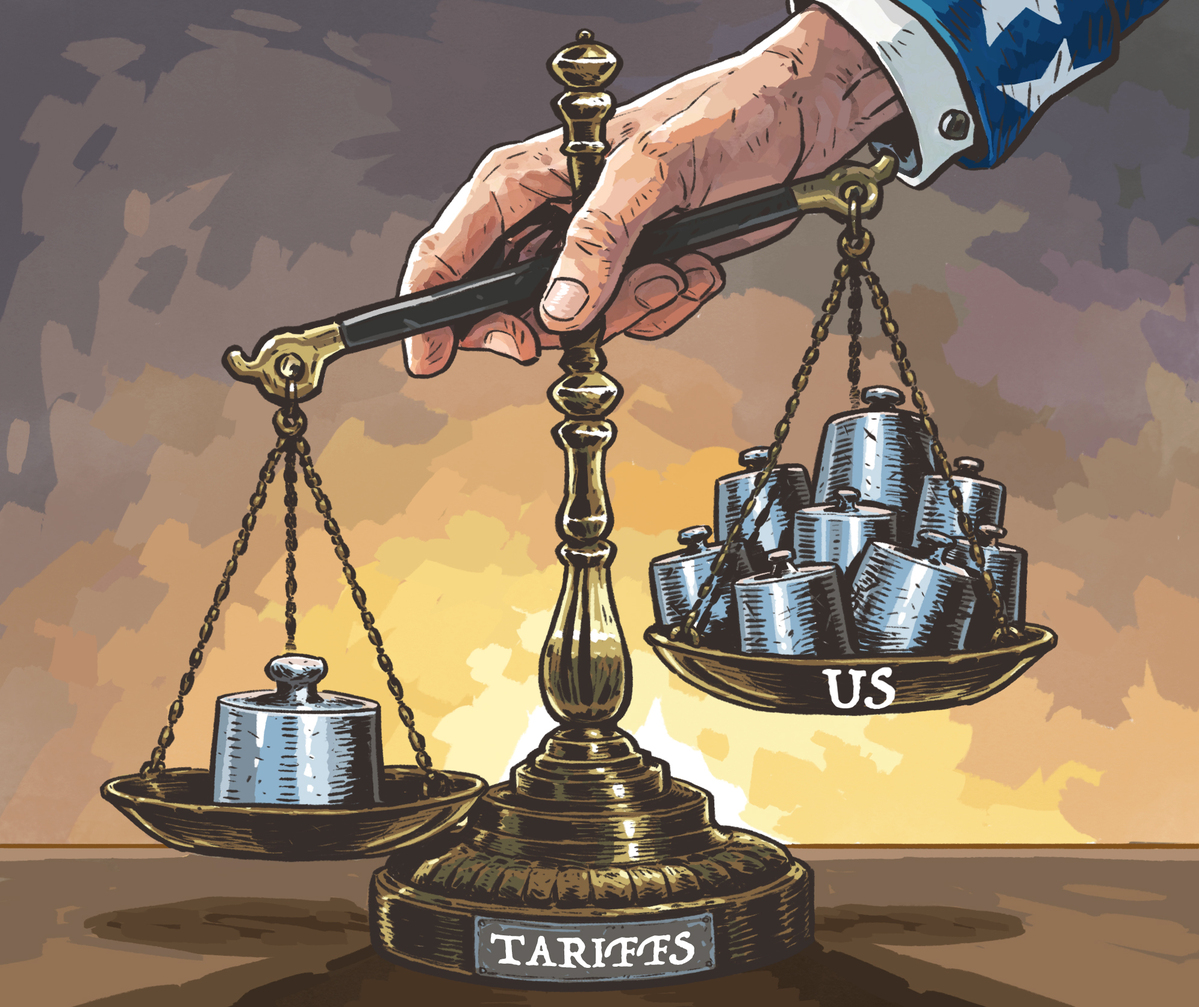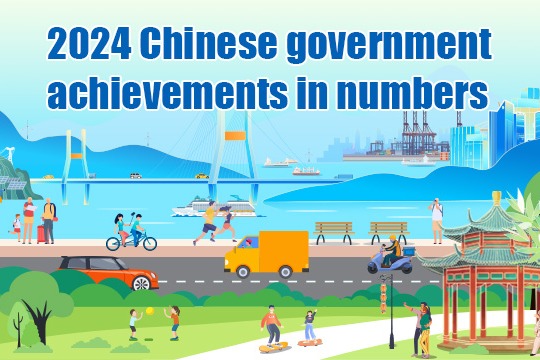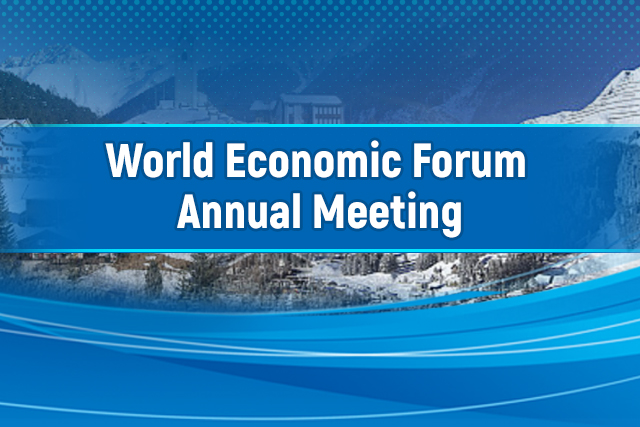Reciprocal tariffs disguise US avarice


The "reciprocal" tariff strategy is an iconic move by US President Donald Trump in his administration. According to Kevin Hassett, director of the US National Economic Council, trading partners of the United States are charging tariffs "two or three times the amount the US is charging" — which is apparently not true, yet has become an excuse for the US to seek so-called reciprocity in its trade with other countries — be it a reduction in tariffs by the other side or an increase in tariffs by the US. The approach to achieving such a goal is simple as well. Take vehicle trade for example, if a country imposes a 40 percent tariff on US auto exports, the US will impose a 40 percent tariff on vehicles from that very same country.
Reciprocal transactions in international trade negotiations normally consist of two basic elements — reciprocal trading conditions and returns, that is, one party gives certain conditions and the other party makes a corresponding return. Reciprocity should be based on mutuality, which is consistent with the basis of international trade practices — interdependence. The reward given on the basis of reciprocity is also a conditional return — good for good, evil for evil. For example, between 2018 and 2020, when the US also ignited trade tensions with China, Washington negotiated with Beijing on a so-called principle of reciprocity and used threatening means before negotiations, but the true nature of seeking such "reciprocity" is purely to benefit the US.
Reciprocity has become a popular term in international trade negotiations nowadays, albeit an overly used one. There are four different scenarios that normally occur in reciprocal trade negotiations. First, trade barriers between A and B should be dismantled on an equal footing so that free trade can be achieved on a reciprocal basis. Second, countries participating in multilateral trade agreements relax trade protection levels to build a multilaterally reciprocal trading dynamic. Third, country A unilaterally raises the level of protection, and country B raises its level of protection on a reciprocal and corresponding basis. Fourth, when country A makes reciprocal demands on countries B, C, and D, the countries will begin their own round of retaliation, and the free trade system is undermined, triggering a proliferation crisis wherein all parties seek reciprocity.
The above four situations have repeatedly appeared in US trade history. This time, chances are that many US households have no idea what so-called reciprocity might mean or look like.
In 1890, the US Congress passed the McKinley Tariff Act, which for the first time formalized "reciprocal trade" as the basis of US foreign trade policy, with aims of expanding US exports, restricting imports and protecting the domestic market. According to the act, the average US tariff level was maintained at 48.9 percent.
When Franklin Roosevelt was in office, Congress passed the Reciprocal Trade Agreements Act of 1934, which reduced tariffs by up to 50 percent. After World War II, Roosevelt combined the principle of unconditional most-favored-nation treatment with the principle of reciprocity so that a reduced tariff level could be applied to any country which the US signed a trade agreement with. Such multilateral reciprocal free trade then became the core of the post-World War II global trading system.
In the 1980s, with the gradual decline of the US in the global trading system as a hegemony and the loss of some of its advantages in trading competition, a group of trade protectionists in the country proposed an aggressive reciprocity to pursue a higher level of trade protection.
And now we're seeing another reciprocity cycle in US trade policy and practice. What could be the new features of the latest round of moves?
First, it is definitely a protectionist move. Peter Navarro, a senior White House adviser on trade and manufacturing, has said: "If President Trump succeeds like he wants to succeed, we are going to structurally shift the American economy from one over-reliant on income taxes and the Internal Revenue Service, to one which is also reliant on tariff revenue and the External Revenue Service." This serves as solid evidence of the protective aspect of Donald Trump's "reciprocal" tariff strategy.
Second, the tendency for aggressive reciprocity never truly leaves the stage. In the 1980s, Japan had its time of honor on the global stage with astounding economic indicators, showing a trend of catching up with and surpassing the US. However, at the time, the US launched a trade war to contain Japan. As with Japan at that time, during the first term of the Trump administration, the US government saw the rise of China's economy as a threat, hence trade conflicts ensued.
Third, there is diffuse reciprocity. Robert Keohane, a US academic and international relations theorist, in his study of international organizations, proposed the concept of diffuse reciprocity, which he defined as a second type of reciprocity. This very type of reciprocity refers to the reciprocal transactions between two parties based on long-term mutual trust and cooperation within the framework of an international organization.
But the reciprocity currently proposed by the US is the fourth type, which will trigger a contagious crisis. Douglas Irwin, a US scholar, wrote in a Wall Street Journal article that "about 200 countries in the world with 13,000 separate tariff lines would lead to 2.6 million individual tariff rates, depending on the product and the country of origin".
The US reciprocal tariff strategy has many drawbacks, and is difficult to build up and regulate, but will only undermine the existing multilateral trading system.
Fourth, the end of the US reciprocal tariff strategy is isolationism. The general meaning of reciprocity includes the recognition of interdependence, while in the context of the current US administration, it will eventually lead to isolation. In the US' reciprocity game, countries will frequently use retaliatory tools, and they will unite to deal with trade woes brought about by the US moves and conclude trade agreements that exclude the US, which will trigger a downtrend for the US and lead to its further isolation.
Additionally, such reciprocity urged by the US is superficially fair but substantively unfair. The US demands "reciprocity" in trade between developing countries, which is like letting a group of average-sized individuals to compete with NBA stars. At present, most of the countries with higher average tariffs than the US are like such "average-sized" players, that is, developing countries, which will be victims of such a "reciprocal" tariff strategy.
Finally, it will be US consumers who pay for the cost of such reciprocal tariff strategies, just as trade specialist William Alan Reinsch wrote in his piece: "Trump's Tariff Reciprocity: 'Reciprocal' tariffs like these will add to inflation and disproportionately hurt poor people, who use a higher percentage of their income to purchase necessities like shoes."
The views do not necessarily reflect those of China Daily.
The writer is a professor at the School of Economics at Renmin University of China.




































